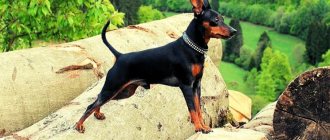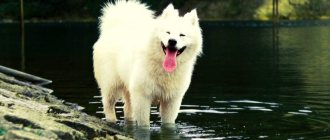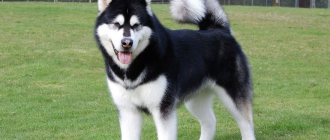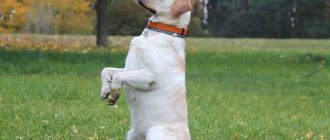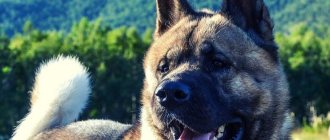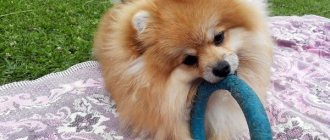Raising a dog is about developing correct behavior. This is the basis for successful training. Training is a set of activities aimed at training specific teams. It is necessary to start raising a puppy from the very first days of his appearance in the house. If you work with your pets from a very early age, then you are on the right track.
Bernese Mountain Dogs are emotional, friendly and loyal dogs. In the past, dogs were used as herders, to carry heavy loads, and to protect yards. They are now ideal companion dogs and family dogs.
- Country of origin : Switzerland
- Height at withers : male: 64–70 cm, female: 58–66 cm
- Weight : male: 38–50 kg, female: 36–48 kg
- Lifespan : 6-8 years
- Use : Companion Dog
- Other names : Bernese Mountain Dog, Greater Bernese Mountain Dog, Bernese Cattle Dog, Bernese Shepherd Dog
When to start training a dog
As soon as a Bernese Mountain Dog puppy appears in your home, immediately begin to build a relationship with him. From the first day it is necessary to provide him with everything he needs: bowls for water and food, collar, leash, bed, suitable food, toys and of course treats. You need to give him a lot of attention so that he feels safe and begins to trust you. From a very early age, your Bernese Mountain Dog puppy needs to be introduced to commands. In addition, in the first months it is necessary to study commands both at home and on the street. First, the puppy must remember its name. We wrote how to choose a suitable nickname in one of our articles. The name should be short, easy to remember and the dog should be called only by it. When the pet has already mastered its name and finally begins to respond, then we move on to commands. By the 3rd month he should master the following commands: “Ugh!”, “Come to me!”, “Place!”, “Nearby!” and “Fetch!” (optional). Then you can move on to the rest, of course, if you need them.
Interesting Facts
A few interesting facts:
- The Bernese Mountain Dog is the most popular breed in Switzerland.
- The ancient Romans put collars with metal spikes on the ancestors of these dogs and used them to attack their opponents.
- In the 15th century, the Bernese Shepherd could have been destroyed. The burgomaster of Zurich decided to exterminate all large dogs from the peasants, but the people resisted and killed the burgomaster.
- In its modern form, the breed appeared thanks to the accidental mating of a Mountain Dog with a Newfoundland, which gave the breed a longer coat and a calm character.
- Alpine peasants believed that they could talk to the gods through berns, since dogs have additional eyes - brown spots above the upper eyelids.
- Rottweilers and Mountain Dogs are descended from the same ancient dog species.
How to raise a Bernese Mountain Dog puppy
If you train your pet correctly, then over time you will get an obedient dog that will follow all commands and delight you every day. Experts believe that several factors may influence the Bernese Mountain Dog's susceptibility to following various commands:
- pet's temperament - the speed of the pet's reaction to stimuli, both positive and negative;
- character - how exactly the dog resists various unpleasant influences;
- obedience - the dog’s ability to accept human leadership;
- vigilance - the speed with which the dog notices potential danger, both in relation to itself and in relation to the owner;
- aggressiveness - the pet’s ability to react hostilely to potential danger;
- curiosity - interest that is developed when a dog feels, hears and sees something;
- sociability - the ability to interact with people;
- possessiveness is the interest shown by animals in certain objects, for example toys.
How quickly your dog will learn commands depends on which traits predominate in the character of your Bernese Mountain Dog puppy. By paying attention to the character traits of your animal, you can find an approach to it and adjust its behavior in certain situations.
- Eagerness will get you nowhere . You should not try to teach your Bernese Mountain Dog puppy all the commands at the same time; you need to learn the commands one at a time. You need to have patience and act methodically. You should not scold your pet at the moment when he makes mistakes, and when he succeeds in something, then the pet should be encouraged.
- Don't hit . It is prohibited to use physical punishment against a pet. You should limit yourself to variable intonation, but avoid shouting. Once your Bernese Mountain Dog puppy is three months old, it is legal to use a light spank while saying “Ew” as punishment. It is necessary to punish immediately when the animal commits an offense, and not after it, since the animal simply will not understand what exactly it was punished for.
- Subsequence . The main goal is to ensure that the pet follows the command the first time. Commands should be pronounced clearly and in an even voice so that the dog understands and obeys you. All family members should be involved in raising the dog, but they must act together. It is forbidden to allow situations in which you scold the puppy, and another family member praises him or simply does not pay attention.
- Pamper . Remember to reward your Bernese Mountain Dog puppy with a variety of treats and praise when he has done what is asked of him.
Feeding
The large size and excellent appetite of the Bernese Mountain Dog require proper and balanced nutrition. Some owners prefer not to rack their brains over the menu and feed their pet ready-made dry food.
It must be good quality feed.
Give preference to formulas with a reduced fat content, as these shepherds have a tendency to gain excess weight.
If the owner prefers to feed his four-legged friend natural food, he must take into account that the diet should be varied. The bulk of it, approximately 70 percent, is meat.
The meat should be stringy and tough. The cartilage tissue contained in it helps strengthen the animal’s ligaments.
You need to diversify the menu with lean fish, boiled and raw vegetables, porridge, dairy products, and eggs. You should not give your pet sweets, baked goods, smoked products and sausages.
Clean drinking water should always be within the Sennenhund's reach! This is especially true on hot sunny days.
Basic commands
You will use some commands more often, others less often. But they will still come in handy to easily interact with your Bernese Mountain Dog and even keep him safe in various situations.
- Aport. One of the most difficult teams. Many people perceive it as very easy and simple, but with many dogs you will have to work hard. This skill is used for other exercises: searching, searching, selecting an item and many others. Usually they are all used in service. When working out a command, “Aport” and “Give” are used, and a gesture is also used.
- Give. On the command “Give” the dog must give up the object.
- Lie. A connecting command that needs to be learned for other commands. In addition, it will not interfere at home or on the street.
- To me. You will need to use this command quite often. So start with it immediately after your Bernese Mountain Dog puppy has learned his name. Never call the dog to punish, and do not scold if it comes on its own, even after mischievousness before it. This behavior on your part may alienate the animal.
- Place. A puppy or an adult dog must clearly know where his place is located. He can sleep anywhere, if you allow it, of course, but he must know this command. You can use it outside the home, marking the place with a leash or your favorite toy.
- Near. It is possible to teach your pet the “Near” command at any age, be it an adult dog or a small puppy. When you move to a new home, you should immediately think about training your puppy.
- Sit. One of the very first commands that a Bernese Mountain Dog puppy should learn.
- Stand. The command is useful in everyday life, for example, for combing a dog.
- . The prohibiting command is one of the most mandatory and taming it begins from the first day the puppy appears in the house. Requiring the command “Fu!”, “No!”, “No!” - immediately stop the unwanted action.
History of the origin of the breed
Like all types of Swiss dogs, the Bernese Mountain Dog historically comes from a village in the Alps. His ancestors were the result of crossing Molossians brought to this land by Roman soldiers two millennia ago (this is evidenced by their powerful, loose physique and other characteristic exterior features) and local shepherd dogs. Confirmation of this is that all types of Mountain Dogs have a characteristic overall color.
The preservation of these dogs as an original species and their separation into separate breeds occurred due to the fact that Berners (one of the names) and other Mountain Dogs did not leave their strictly defined habitat and did not mate with each other. The reason is that, unlike wild predators, they did not need food migration. Life with a man was mutually beneficial for both: the big strong dog protected the owner and helped him, and the owner provided shelter and food.
The big dog was used everywhere:
- she confidently collected sheep and cows, returning individuals who were trying to fight back into the collective;
- it was harnessed to a small cart, on which cans of milk were transported or small children were simply rolled around, and, if necessary, adults were transported;
- Sennenhunds guarded the home and looked after the children of the owners.
The official history of the breed begins in the last century: at that time, this breed began to be revived, since the number of Mountain Dogs had declined catastrophically. The efforts of the breeders were crowned with success; in 1910, at a dog exhibition, firstly, about a hundred of these beautiful large dogs appeared before the eyes of visitors, and secondly, the breed was officially given its current name. At the exhibition this breed was listed as Dürbechler.
Raising a dog
Education is the process of shaping the behavior of a Bernese Mountain Dog acceptable to the owner, when this behavior is not regulated by commands.
During upbringing, a dog develops relationships with its owner, family members, passers-by, behavior in the house, on the street, and relationships with other dogs. The training process begins immediately when the dog first appears in the house and continues throughout the dog’s life. Regardless of the dog's breed, it must be trained. Just as people do not like ill-mannered people, dogs should also know what is allowed and what is not allowed. Raising a dog is a rather complex process, which is not limited to learning just a few commands. The main goal of education is that the dog should become pleasant to talk to. In addition, it must be manageable at some points, otherwise it will be very difficult for the dog owner. In the broadest sense of the word, dog training is about teaching the dog commands such as “Bad” and “No”. But besides this, the dog must know what is good and what is bad, even in those moments when the owner is not around. Some people believe that the Bernese Mountain Dog only understands commands, but cannot generalize. Only those who, as a rule, never had dogs, and studied them only in laboratory conditions, in which dogs were not able to show their full potential, are convinced of this, as well as those who, due to their personal qualities, were unable to establish a relationship with pet. In real life, the Bernese Mountain Dog is a pack animal and therefore, like any other pack animal, needs to communicate with members of its family. In this situation, the dog’s family members are people. It is quite stupid to think that if a dog caresses you, this means that his skin is itching. In order for a dog’s nervous system to function normally, it needs affection, love, communication, and praise. In addition, so-called “inhibiting factors” are required, because if the dog is allowed everything, then this will not lead to anything good. When raising a Bernese Mountain Dog puppy, you should pay attention to the genetic characteristics of the breed. A family is a pack in which there must be a leader, in this case the leader is a person. The leader punishes, plays, feeds, caresses, praises and scolds. All other members of the owner's family are ranked by rank. At that moment, while the puppy is small, all other family members are senior to him. However, in the process of growing up, around the age of one year, the dog begins to look for its place in the hierarchical pyramid. Naturally, she will try to take the step that is as high as possible. She can do this with the help of force, in the case of large dogs, or with the help of cunning, as small dogs do. The more ill-mannered the dog is, the more difficult this process will be. If the owner from the first days shows his pet that the one who has the power is right, then he will turn out to be a frail neurotic or an evil beast with whom you will hardly communicate with joy. A Bernese Mountain Dog puppy must understand that he must obey people, since they love him, feed him, and raise him. Understand that prohibitions are not the whim of the owner, but a way to protect everyone from trouble. The main influence on the dog should be the voice. From the first days of being in your home, the puppy must realize that you love him, and if you raise your voice, then this means that he is doing something wrong. One of the best incentives for a pet is considered to be a treat, which should be given out for good behavior and listening to commands. Training and education of the Bernese Mountain Dog
Vaccinations and susceptibility to disease
Vaccinations for Bernese Mountain Dogs are done according to the standard scheme:
- at 1.5–2 months – from hepatitis, plague, parvovirus enteritis, leptospirosis;
- at 6 months - repeated vaccination plus rabies vaccination;
- per year and subsequently annually - comprehensive vaccination against these diseases.
On a note. Before each vaccination, your pet must be treated for worms.
Lifespan
On average, Bernese Mountain Dogs live about 8-10 years.
In a private home with the possibility of free walking and properly organized nutrition and physical activity, the Bernese Shepherd lives a little longer - up to 12–13 years.
Modern living conditions make it difficult to provide the dog with appropriate care in the apartment, which leads to the occurrence of various diseases.
Bernese Mountain Dogs are characterized by:
- joint dysplasia;
- eye diseases;
- osteochondrosis;
- hernia;
- alopecia;
- eczema.
Allergies are very common in shepherds.
This breed has a predisposition to developing cancerous tumors. They occur in almost half of dogs.
Breeders work hard to increase the lifespan of the Bernese Mountain Dog. The lack of statistics and general veterinary records prevents the development of effective measures to increase the life of this beautiful breed.
Pros and cons of the breed
AdvantagesDisadvantages
| friendly and kind | sheds a lot |
| has high intelligence | will live no more than 12 years |
| loves children | needs long, albeit inactive walks |
| clean and unpretentious | |
| demonstrates exceptional loyalty |
The Bernese Mountain Dog is a very beautiful and kind dog, capable of becoming the most reliable friend with proper training. It is not for nothing that Bernese Shepherds make good guide dogs: these calm and thorough dogs are devoted to their owners and are sincerely happy if they can help them.
What problems might you encounter?
Good heredity, proper care and maintenance of the animal will allow you to raise a healthy pet.
But a sedentary lifestyle and poor nutrition will lead to the following diseases:
- inflammation and osteochondrosis of the joints;
- deterioration of the coat, even to the point of baldness;
- skin diseases, dermatitis;
- weakened vision;
- oncology of various organs;
- problems with the genitourinary system, pyelonephritis, urolithiasis.
In addition, the dog does not tolerate prolonged exposure to heat.
Balanced food taking into account the age and mobility of the dog, walks in the air, training, games - all these activities will help maintain the health of the pet for many years.
